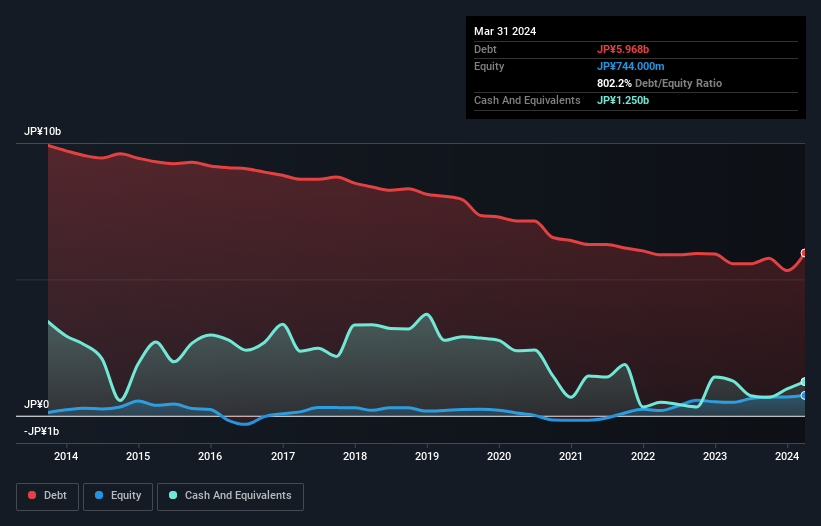Warren Buffett famously said, 'Volatility is far from synonymous with risk.' When we think about how risky a company is, we always like to look at its use of debt, since debt overload can lead to ruin. We can see that Taiyo Bussan Kaisha,Ltd. (TSE:9941) does use debt in its business. But is this debt a concern to shareholders?
When Is Debt A Problem?
Generally speaking, debt only becomes a real problem when a company can't easily pay it off, either by raising capital or with its own cash flow. Ultimately, if the company can't fulfill its legal obligations to repay debt, shareholders could walk away with nothing. However, a more usual (but still expensive) situation is where a company must dilute shareholders at a cheap share price simply to get debt under control. By replacing dilution, though, debt can be an extremely good tool for businesses that need capital to invest in growth at high rates of return. When we examine debt levels, we first consider both cash and debt levels, together.
View our latest analysis for Taiyo Bussan KaishaLtd
What Is Taiyo Bussan KaishaLtd's Net Debt?
As you can see below, at the end of March 2024, Taiyo Bussan KaishaLtd had JP¥5.97b of debt, up from JP¥5.57b a year ago. Click the image for more detail. However, because it has a cash reserve of JP¥1.25b, its net debt is less, at about JP¥4.72b.

How Strong Is Taiyo Bussan KaishaLtd's Balance Sheet?
We can see from the most recent balance sheet that Taiyo Bussan KaishaLtd had liabilities of JP¥6.99b falling due within a year, and liabilities of JP¥145.0m due beyond that. On the other hand, it had cash of JP¥1.25b and JP¥4.27b worth of receivables due within a year. So its liabilities outweigh the sum of its cash and (near-term) receivables by JP¥1.62b.
This is a mountain of leverage relative to its market capitalization of JP¥1.74b. Should its lenders demand that it shore up the balance sheet, shareholders would likely face severe dilution.
We use two main ratios to inform us about debt levels relative to earnings. The first is net debt divided by earnings before interest, tax, depreciation, and amortization (EBITDA), while the second is how many times its earnings before interest and tax (EBIT) covers its interest expense (or its interest cover, for short). The advantage of this approach is that we take into account both the absolute quantum of debt (with net debt to EBITDA) and the actual interest expenses associated with that debt (with its interest cover ratio).
Taiyo Bussan KaishaLtd has a rather high debt to EBITDA ratio of 16.9 which suggests a meaningful debt load. However, its interest coverage of 5.4 is reasonably strong, which is a good sign. Pleasingly, Taiyo Bussan KaishaLtd is growing its EBIT faster than former Australian PM Bob Hawke downs a yard glass, boasting a 170% gain in the last twelve months. When analysing debt levels, the balance sheet is the obvious place to start. But you can't view debt in total isolation; since Taiyo Bussan KaishaLtd will need earnings to service that debt. So when considering debt, it's definitely worth looking at the earnings trend. Click here for an interactive snapshot.
Finally, a business needs free cash flow to pay off debt; accounting profits just don't cut it. So the logical step is to look at the proportion of that EBIT that is matched by actual free cash flow. Over the last three years, Taiyo Bussan KaishaLtd saw substantial negative free cash flow, in total. While that may be a result of expenditure for growth, it does make the debt far more risky.
Our View
To be frank both Taiyo Bussan KaishaLtd's net debt to EBITDA and its track record of converting EBIT to free cash flow make us rather uncomfortable with its debt levels. But at least it's pretty decent at growing its EBIT; that's encouraging. Looking at the balance sheet and taking into account all these factors, we do believe that debt is making Taiyo Bussan KaishaLtd stock a bit risky. That's not necessarily a bad thing, but we'd generally feel more comfortable with less leverage. There's no doubt that we learn most about debt from the balance sheet. However, not all investment risk resides within the balance sheet - far from it. We've identified 2 warning signs with Taiyo Bussan KaishaLtd (at least 1 which doesn't sit too well with us) , and understanding them should be part of your investment process.
If you're interested in investing in businesses that can grow profits without the burden of debt, then check out this free list of growing businesses that have net cash on the balance sheet.
Valuation is complex, but we're here to simplify it.
Discover if Taiyo Bussan KaishaLtd might be undervalued or overvalued with our detailed analysis, featuring fair value estimates, potential risks, dividends, insider trades, and its financial condition.
Access Free AnalysisHave feedback on this article? Concerned about the content? Get in touch with us directly. Alternatively, email editorial-team (at) simplywallst.com.
This article by Simply Wall St is general in nature. We provide commentary based on historical data and analyst forecasts only using an unbiased methodology and our articles are not intended to be financial advice. It does not constitute a recommendation to buy or sell any stock, and does not take account of your objectives, or your financial situation. We aim to bring you long-term focused analysis driven by fundamental data. Note that our analysis may not factor in the latest price-sensitive company announcements or qualitative material. Simply Wall St has no position in any stocks mentioned.
Have feedback on this article? Concerned about the content? Get in touch with us directly. Alternatively, email editorial-team@simplywallst.com
About TSE:9941
Adequate balance sheet with low risk.
Market Insights
Community Narratives




